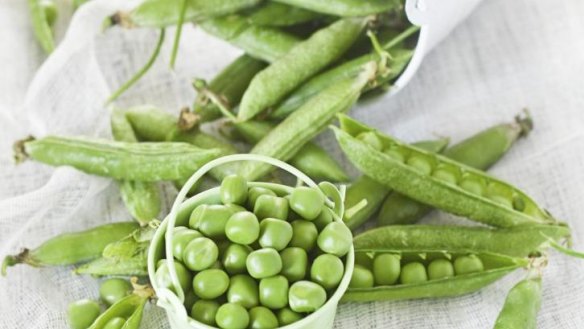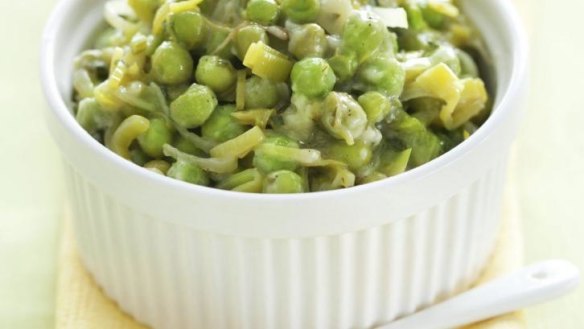How to grow peas in Canberra

Freshly picked, tender peas are just wonderful. Growing them in your own garden allows you to taste the freshest peas possible, from paddock to plate. Now is a good time to be planting, as the soil is still warm and the sun keeps shining. Shelling super sweet, home-grown peas can be a real family event, even for small children. And the seeds are a good size for the little ones to also help with planting.
As with other legumes, peas are an ancient food crop that was being planted in the Mediterranean lands at least 9000 years ago. By the time of the major Greek and Roman Empires the humble pea had become a staple. They were taken by traders to Afghanistan and India about 4000 years ago. Peas were either ground or dried until well into the 16th century. When mixed with wheat or other cereal flours, peas became an essential ingredient in much bread making.
In the 16th century, some research gardeners in Italy set about to breed more tender varieties. These new varieties could simply be cooked in water or even eaten fresh.

When the vegetable made its way to China, the experimental gardeners of the Middle Kingdom set about developing flat pod varieties which we call snow peas.
There are two groupings of the main shelling peas: those which are climbing and those which are dwarf-sized plants. As with the beans we grow in summer, the climbing varieties generally take a little longer to grow but they are higher yielding and produce a crop over several weeks.
Telephone is an heirloom variety with large pods that grows as a climbing pea. The plants can grow to a height of 1.8 to 2 metres so they will need a sturdy fence or trellis to grow on. It will produce a crop after 12 weeks and keep bearing for three to five weeks.
Greenfeast is the most widely planted bush pea. It is hardy and disease resistant and matures in 12-14 weeks. It will produce a good crop but not keep on bearing as long as the climbing pea varieties. Massy Gem is a faster maturing bush type pea (10-12 weeks) and it can also withstand harsh growing conditions. This variety is also known in Victoria as the Melbourne Market pea.
Peas are really a cool season crop which do best in a garden bed enriched with plenty of old compost. The main planting season is autumn so the plants will grow through winter and produce a fine harvest in spring. When it comes to cropping time, heavy frosts will damage the beautiful white flowers so you may have to wait a few days for more flowers to come and set pods.
Plant peas to a depth of two to three centimetres and leave 60-70 centimetres between each seed along the row. You could plant double rows, just 20 centimetres apart and then allow 45-50 centimetres to the next rows. Give the bed a good watering after sowing then allow the seeds to germinate, which can be 10 to 14 days after planting.
Peas do not like to compete with weeds so apply a good amount of mulch around the little emerging plants. Then enjoy the bright sunny days of winter to keep them clear of weeds.
Braised peas, shallots and lettuce
In previous centuries peas and lettuce were often cooked and served as an accompaniment to the main meal. It is still often prepared in this way in France.
100g bacon pieces
50g butter
2 onions, finely chopped
12 shallots, chopped
2 garlic cloves, crushed
500g shelled fresh peas
200g sugar snap peas, halved
3 parsley sprigs
1 tsp castor sugar
250ml chicken stock
2 baby cos lettuce, finely shredded
juice of 1 lemon
black pepper and salt
Optional: 1 tbsp plain flour
Place the bacon pieces in a small pot with cold water and bring to the boil. Strain and set aside. Melt the butter in a large saucepan and add in the onions, shallots and garlic on high heat. Cook for 3-4 minutes, stirring continually, until the onion and shallots have softened. Add in the bacon for another minute then reduce the heat to moderate and add the peas, parsley and sugar. Pour in the chicken stock and stir well. Cover and cook for another five minutes, until tender. If necessary thicken with a little flour, mixed first in a little water. Add in the shredded lettuce, the lemon juice and season with freshly ground black pepper and salt. A delicious dish when served with fish.
This week in the garden
Plant rocket, mustard greens, kale and shallots for winter. Plant out a last row of beetroot and turnips.
Plant out onion seeds into punnets. Creamgold and Red Spanish are two good varieties for the colder climates.
It is a good time to plant a green manure crop of oats, rye, mustard or broad beans into garden beds that would otherwise be fallow over winter. You will dig the leafy crops back into the soil in late winter to build up the humus content.
Trim off excess leaves from strawberry plants and look for well-rooted runners to be transplanted over the next month.
Harvest your last pumpkins by leaving as much vine attached as possible and placing them in a sheltered, dry spot to allow the skins to harden for keeping over winter.
If you have any late, green tomatoes still on the plants, remove the plants and hang upside down in your garage or shed to provide extra days for the tomatoes to ripen.
Owen Pidgeon runs Loriendale Organic Orchard near Hall.